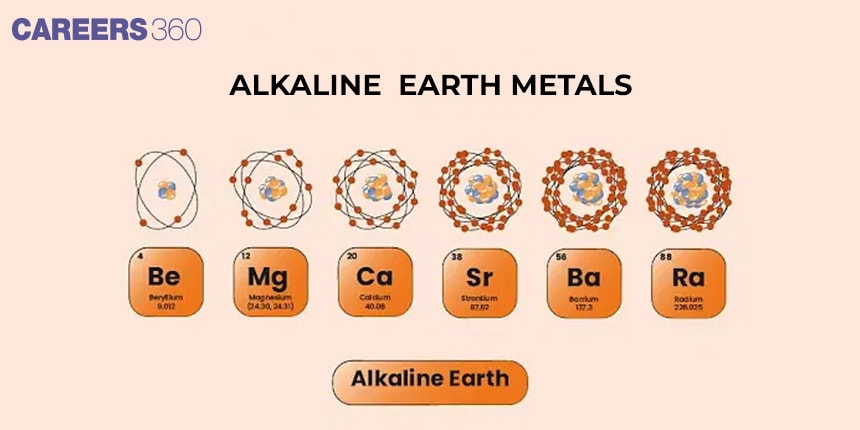Alkaline earth metals
The alkaline earth metals are a team of six chemicals within the periodic desk made up using beryllium(Be), magnesium(Mg), calcium(Ca), strontium(Sr), barium(Ba), and radium(Ra). All of these elements have various properties that are physical and chemical in nature which ensures they find use across different industries and life forms. Alkaline earth metals are shiny, silvery-white in color, and high density such as alkali metals. As they are more metallic (i.e. the bonding is stronger) their melting points and boiling points tend to be higher than those of alkali metals This is the case for their electronic configuration containing 2 electrons in s-orbitals of the highest energy which they tend to lose forming diatomic cations hence +2 oxidation state.
NEET 2025: Mock Test Series | Syllabus | High Scoring Topics | PYQs
JEE Main: Study Materials | High Scoring Topics | Preparation Guide
JEE Main: Syllabus | Sample Papers | Mock Tests | PYQs
- Alkaline Earth Metals(Physical Properties)-
- Some Solved Examples
- Conclusion

Alkaline Earth Metals: Uses, Safety, and Some Important Points An example is beryllium dust, which is so toxic that it causes chronic lung disease and berylliosis. These barium compounds are useful but they need to be handled with care as all of them contain barium which is one of the toxic elements. Because radium is radioactive, it carries several health hazards and requires regulated management
Also read -
- NCERT Solutions for Class 11 Chemistry
- NCERT Solutions for Class 12 Chemistry
- NCERT Solutions for All Subjects
Alkaline Earth Metals(Physical Properties)-
- Electronic configuration
- These elements have two electrons in the s-orbital of the valence shell. Their general electronic configuration may be represented as [noble gas]ns2. Like alkali metals, the compounds of these elements are also predominantly ionic.
- Atomic and Ionic Radii
- The atomic and ionic radii of the alkaline earth metals are smaller than those of the corresponding alkali metals in the same periods. This is due to the increased nuclear charge in these elements. Within the group, the atomic and ionic radii increase with the increase in atomic number.
- Density
These metals are denser than alkali metals in the same period because these can be packed more tightly due to their greater nuclear charge and smaller size. The density decreases slightly up to calcium and then increases up to radium. - Melting and Boiling points
The melting and boiling points of these elements are higher than the corresponding alkali metals. This is due to the presence of two electrons in the valence shell and thus, strongly bonded in the solid state. However, melting and boiling points do not show any regular trend because atoms adopt different crystal structures. - Ionization energy
The alkaline earth metals have low ionization enthalpies due to the fairly large size of the atoms. Since the atomic size increases down the group, their ionization enthalpy decreases. The first ionization enthalpies of the alkaline earth metals are higher than those of the corresponding Group 1 metals. This is due to their small size as compared to the corresponding alkali metals. It is interesting to note that the second ionization enthalpies of the alkaline earth metals are smaller than those of the corresponding alkali metals. - Electropositive or metallic character
The electropositive character of these elements increases down the group as the ionization enthalpy value decreases.
Recommended topic video on(Alkaline earth metals)
Some Solved Examples
Q.1 Which of the following has 2s2 outermost electronic configuration?
1) Mg
2) Li
3) Be
4) B
Solution:
As we learned
Electronic Configuration of beryllium -
4Be→1s22s2 or [He]2s2
Electronic configuration of Be: 1s2 2s2
Hence, the answer is the option (3).
Q 2. Which of the following has the smallest atomic size?
1) Mg
2) Be
3) Sr
4) Ca
Solution:
As we learned
Atomic and Ionic Radii
The atomic and ionic radii of the alkaline earth metals are smaller than those of the corresponding alkali metals in the same periods. This is due to the increased nuclear charge in these elements. Within the group, the atomic and ionic radii increase with the increase in atomic number.
As we move down the group, the atomic size of elements increases, so Be has the smallest size.
Hence, the answer is the option (2).
Also check-
- NCERT Exemplar Class 11th Chemistry Solutions
- NCERT Exemplar Class 12th Chemistry Solutions
- NCERT Exemplar Solutions for All Subjects
NCERT Chemistry Notes:
Conclusion
These observations led to the conclusion that alkaline earth metals are important both industrially and in biological systems. Many of their unique characteristics make composites vital throughout many industries and sectors, from construction to manufacturing; love them or hate them: composite materials are here to stay!!! The possibilities of these truly amazing substances are likely to become even broader as research and technology continue to evolve. Calcium and magnesium, in particular, are important for maintaining human health by supporting bone formation as well as enzymatic activities. Thus, the broad applicability and biological significance of alkaline earth metals reveal their inescapable impact on new technologies as well as life itself.
Frequently Asked Questions (FAQs)
Alkaline earth metals are a group 2 of the periodic table. They include beryllium, magnesium, calcium, strontium, barium, and radium.
They are called alkaline earth metals because their oxides are basic.
Alkaline earth metals react with water to form hydroxides and hydrogen gas. The reactivity increases from beryllium to barium.
Radium is radioactive because its nucleus is unstable and decays over time, emitting radiation in the form of alpha particles, beta particles, and gamma rays.
Alkaline earth metals are shiny, silvery-white, and somewhat reactive at standard temperature and pressure. They have two electrons in their outermost shell.
Also Read
19 Feb'25 10:44 AM
17 Dec'24 10:24 AM
17 Dec'24 10:21 AM
29 Nov'24 12:13 PM
30 Sep'24 02:31 PM
30 Sep'24 11:46 AM
26 Sep'24 06:10 PM
26 Sep'24 05:53 PM